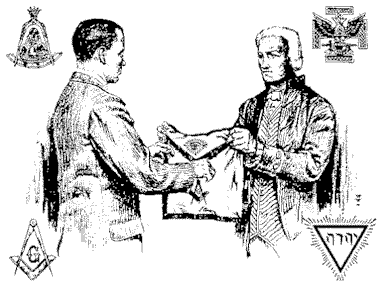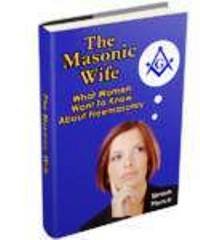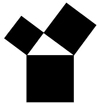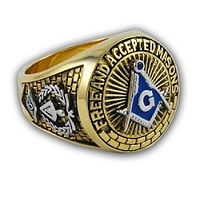Square and Compasses
Freemasonry's Universal Logo
The Square and Compasses (or, more definitively,...a Square and a set of Compasses which are joined together...each leg of the compass pointing in opposite directions) is the single most universally identifiable symbol of Freemasonry.

Due to slight Masonic jurisdictional differences around the world, this symbol does not always look exactly the same to all Freemasons.
Some jurisdictions call this symbol the Square and Compass, (non-plural) and a few jurisdictions omit the "G" at its center.
But, no matter its slightly different look, all Freemasons are in unison as to what this symbol means to them within the fraternity.
Speculative Masonic Symbolism of the Square and Compasses
In speculative Freemasonry, this emblematic symbol is used in Masonic ritual.
The Square is an emblem of virtue in which we must "square our actions by the square of virtue with all mankind".
The Compasses exemplify our wisdom of conduct,... the strength to "circumscribe our desires and keep our passions within due bounds".
When these 2 Masonic tools are placed together with God (the Creator) as our central focal point... (just as King Solomon built God's Temple, first... and then built his house around it), peace and harmony is the result.
The Information below may be found in Mackey's
Revised Encyclopedia of Freemasonry, Volume 2, Page 963, 1929.
A Short History About the Square and Compasses
THE SQUARE...Morality
THE COMPASS...Boundaries
Trying Square: In the operative stone mason era, the 90 degree angle of the square was a necessary tool used to test the accuracy of the sides of a stone to ascertain that the stone's angles matched the square's "true" right angle.
Morality: In speculative Freemasonry, the square is a symbol of morality.
Official Masonic Usage:
- It is one of the 3 Great Lights (the Square, the Compass and the Holy Book)
- In each of its above roles, it inculcates (teaches) the repeated lesson of morality, truthfulness and honesty.
Common Usage: The square is so universally accepted that it has found its way into colloquial language with which we communicate on a daily basis. We have all heard the sayings: "Getting a square deal; Are you on the square? and Squaring off".
While the specific date with which the Masonic square became an official Masonic symbol is not known, it was one of the primary tools which an operative mason used in his craft.
In France, one leg is longer than the other due to the nature of its original construction (see Euclid's 47th Proposition).
The American Freemason square has equal length "legs", however it has been unnecessarily marked off in increments of inches, as if to measure length and breadth, which is not its true purpose.
An Antique Square: In 1830, an architect who was rebuilding an ancient bridge called Baal Bridge near Limerick, Ireland removed the foundation stone of the bridge and found a much eaten away old brass square. On the surfaces of its 2 legs, was the following inscription:
"I will strive to live - with love and care - upon the level - by the square." It was dated 1517.
1725: In one of the very earliest catechisms (rituals) we find these
words:
Q: "How many make a lodge?
A: God and the Squares, with 5 or 7 right or perfect Masons."
1880: Excerpt from a speech delivered by Brother Herbert A. Geles, Worshipful Master of Ionic Lodge No. 1781, at Amoy, entitled "Freemasonry in China"
"From time immemorial, we find the Square and Compasses used by Chinese writers to symbolize precisely the same phases of moral conduct as in our system of Freemasonry.
The earliest passage known to me (Albert Mackey) which bears upon the subject is to be found in the Book of History, embracing the period reaching from the 24th to the 7th century before Christ. It is there, in an account of a military expedition, that we read:
"Ye officers of government, apply the Compasses!"
In another part of the same records, a Magistrate (judge) is spoken of as:
"A man of the level, or the level man."
481 B.C.: The public discourses of Confucius provide us with several Masonic allusions of a more or less definite character. When recounting his own degrees of moral progress in life, the Master tells us that only at 75 years of age could he venture to follow the inclinations of his heart, without fear of transgressing the limits of the Square."
Circa 281 B.C.: In the works of Mencius, a follower of Confucius, is a fuller and more impressive Masonic phraseology:
Book vi: "The Master mason in teaching his apprentices, makes use of the Square and the Compasses. Ye who are engaged in the pursuit of wisdom must also make use of the Square and the Compasses."
300-400 Years Before Christ: In the Great Learning, Chapter 10, believed to have been written circa 300-400 B.C., we read that a man should abstain from doing unto others what he would not they should do unto him; "this," adds the writer, "is called the principle of acting on the Square."
Of course, we are familiar with this statement today, as the Golden Rule, as also found in the Bible.
Possibly most interesting of all is the fact that the symbolism recorded of the Square permeates equally so many languages across the world, (sic: over nearly 2400 years) and, in each of them, the Square has preserved it original symbolism...as the symbol of morality."
End of Albert Mackey's dissertation on the Square and Compasses.
Tools of the Craft:
Historically, both the square and compasses are architect's tools to create true and perfect lines and angles. Operative stone masons used them as the tools of their trade. Like most tradesmen throughout history, operative stone masons began their career as an entered apprentice under the supervision of a Master mason.
From Entered Apprentice to Master Mason: After several years, if their work was pleasing to the Master stone mason, the entered apprentice was elevated to the title of a Fellowcraft.
More years passed and if the Fellowcraft's work was deemed acceptable to the Master, he was allowed to begin work upon his Master's piece (the word "Masterpiece" is another colloquialism we now commonly use in our everyday speech).
Upon the Fellowcraft's passing this final test, he was raised to the degree of Master mason of the craft.
Wisdom: Like men, buildings are not erected overnight and the knowledge of any craft takes time to hone. Each building must have a sturdy foundation with which to build upon.
Wisdom is the learned ability to utilize the accumulated knowledge of enlightenment, experience and intuitive understanding coupled with the capacity to apply them with good judgment toward achieving a prudent course of action.
Strength and Beauty: Operatively, the Square and Compasses were tools used to build strong foundations and to craft geometrically and precision cut stones, one atop another in symmetrical form to create a useful edifice (large and imposing building) which was both sturdy, durable and rock-solid against the elements (strength) as well as visually pleasing (beauty) to those who beheld it.
Square and Compasses...Masonic Symbols
Not only is the symbol of the Square and Compasses seen on Masonic Regalia in the lodge, but Master Masons proudly wear it on Masonic clothing such as Masonic shirts and Masonic jackets.
Among pieces of Masonic jewelry at the lodge level such as Masonic rings and Masonic lapel pins, the Square and Compasses is the most often seen Masonic symbol.
Masonic rings display the Square and Compasses in a vast array of metals and jewels...with both Gold Masonic rings and Silver Masonic rings being equally popular.
You will also find the Square and Compasses on such items as Masonic hats, Masonic tie clips, Masonic lapel pins and even Masonic brass door knockers....
If you have ever walked through the parking lot at Grand Lodge when members of the brotherhood attend their Grand Lodge's Annual Communication each year; you will also see the depth of loyalty that Freemasons so willingly accord their fraternity.
There are more vehicles with Masonic auto emblems...comprised mostly of this Masonic logo than those without them.
Square and Compasses Copyright
The Square and Compasses image is copyrighted. Brethren are free to use the square and compasses for the promotion of Freemasonry, however, commercial or business usage is prohibited.
Commercial or business use means that you may not start a company and use the Square and Compasses image as your logo.
5 Fast Methods To Find the Information You Want to Learn About
- Search Box - Use the Search Box at the top of your page.
- Site Map - Use my Site Map page to find the topics you are most interested in.
- Carousel - Use the carousel of pages at the top of your screen.
- Menu Icon - On MOBILE, click the MENU button at the top of each page.
- Masonic Books - Browse through a selection of Masonic books.








